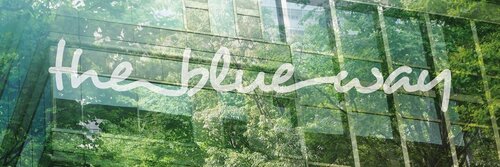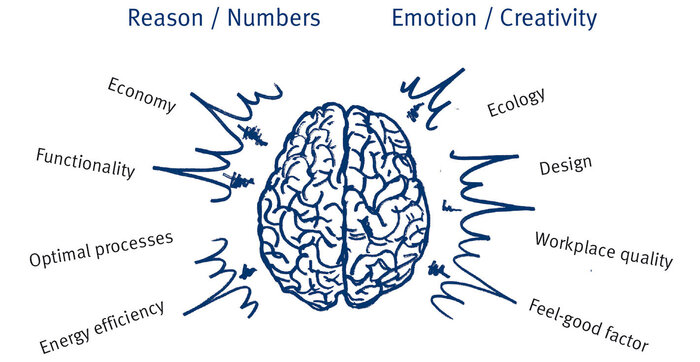
the blue way
We think and act sustainably and holistically. In doing so, we take all facets of sustainability into account. Economy, ecology and functionality are inseparable for us.

We call this basic principle ‘the blue way’. It pervades our entire company – internally and externally.
‘the blue way’ combines reason and emotion. Stringent, goal-oriented processes that allow space for creative freedom. In our projects, we always include the creative right hemisphere of the brain and the rational left hemisphere. This results in holistic thinking.

Our cooperation is based on partnership and transparency. We have a financial focus. We want to grow and generate good profits. We share these earnings with our employees. ‘the blue way’ also governs our interaction with our clients.
‘the blue way’ milestones
The Innovation Hub offers space for innovations and a wide range of uses on three floors. Visitors can expect an impressive mix of industrial character, sustainable conversion, future-oriented working environments and innovative building services engineering.
Building materials that present no risk to health, that promote wellbeing and that can easily be recycled after use are an important step toward the circular economy. In an effort to achieve these objectives Drees & Sommer is working together with like-minded partners on the www.Building-Material-Scout.com digital platform. Experts use the platform to gather and structure information on building materials, and then make it available to industry stakeholders.
LCM Digital is a web-based production planning and management platform for successful control of planning and construction processes.
In the future, buildings will be perfectly tailored to meet the needs of their users. Digitization makes this possible, and people’s changing requirements demand this kind of flexibility. Drees & Sommer is meeting the challenges of tomorrow with buildings that function perfectly, linking elements such as clients’ requirements for workplace design, architecture, sustainability and cost-effectiveness.
Mit eWe support clients through the digital transformation by providing consultation services on an economic basis specifically directed at anything and everything relating to ICT. Drees & Sommer experts are extremely skilled in focusing their consultancy services on clients’ strategic requirements and in designing and supporting projects operating at the interface between digitization, IT and construction. We provide stimulus and ideas, and we bring the latest developments into line with IT and construction project imperatives. Click here to find out more.
Germany's roads are in constant need of attention, requiring over two billion euros to be spent on them every year because poor quality road construction has created a constant need for remedial work to be undertaken.
As leader of the consortium working on the SmartSite research project, Drees & Sommer is therefore getting road construction ready for the digital future. The project is concerned with the cloud-based, autonomous control of road construction machinery, aimed at improving project quality and making projects run more efficiently while consuming as little energy and as few resources as possible. Click here to find out more about the SmartSite research project.
More and more people are living in cities the whole world over. Numerous developments – many of them mutually exacerbating – produce a whole range of challenges for urban living. The resulting tasks require cooperation across a range of different disciplines, requiring various aspects of urban spaces – including economic, ecological, functional, social and aesthetic aspects – to be taken into account.
Energy, climate, resources, mobility, infrastructure, digitization, finance and society – all of these issues have an impact on cities and affect urban living.
With the blue way very much in mind, we provide networked solutions under the motto Blue City – Integrated Urban Solutions and combine individual components in such a manner that we can develop integrated approaches and concepts tailored to the specific challenges facing our clients.
This includes mobility concepts for municipalities and companies, amongst other entities, enabling companies, in particular, to score more and more highly in their infrastructure environment, thereby helping them compete for the best people.
The demands on buildings are increasing. They are required to be networked, energy self-sufficient, zero-emissions, healthy, integrated und flexible. One key element prevents them becoming true Blue Buildings: operating efficiency. Digital Blue integrates digitization. This results in better, more economically viable buildings – fully in keeping with the spirit of ‘the blue way’.
We achieve this, in part, through digital design with Building Information Modeling (BIM), as well as through modular construction and lean management. The Cradle to Cradle® approach also benefits from digitization. The material passport contains all relevant information on the materials and designs used in the project from a building ecology perspective.
Electricity consumption in Germany in 2012 amounts to approximately 600 million megawatt hours, with around 44 percent of this figure attributable to industry, commerce and trade, and a further 28 percent each to transport and domestic use. Around 80 percent of base load is generated by conventional means, i.e. from nuclear power, coal, gas and oil.
If around half of Germany’s energy is to be generated from renewable sources from 2030 onwards (rising to around 80 percent by 2050), a holistic approach will need to be taken. The most important actions required are to reduce energy consumption, adopt new approaches and technologies in energy production, develop innovative procedures in energy storage, and ensure efficient and intelligent power distribution.
In this context, the blue way means integrating the required measures within an overall process. Politicians have to define the way of proceeding and ensure that funding is provided for the necessary network upgrades. The energy industry has to ensure that renewable energy is available at competitive prices. This move requires a complete overhaul of funding policy and of the German Renewable Energies Act (Erneuerbare Energien Gesetz, EEG).
Many established properties have one key flaw. They are excessively expensive to operate. High consumption values make the properties uneconomical. And gradually, the number of tenants declines. Measures must be taken to improve performance. But how can these be economically planned and implemented? A typical task for holistic solutions in line with ‘the blue way’. Because when it comes to complex renovation projects, it is crucial to keep the owner’s overall strategy front of mind. This is ensured by our tiered analysis, in which we combine possible options with a holistic perspective. We then recommend courses of action specifically tailored to the particular case, and implement the measures involved. A revitalized building must be more economical than before – only then does the strategy work in the sense of ‘the blue way’.
In numerous discussions with principals, property managers and politicians about sustainability and Green Building, we often hear same comment: ‘I am really interested in the subject, but know far too little about it to form an opinion and join the discussion.’
So we launched a campaign to close such gaps in knowledge in a simple and understandable way. It started with Expo Real 2008, followed by a whole series of presentations, client events, press releases, and the publication of the reference book Green Building. Thanks to our campaign, Green Building has become firmly established in the real estate industry. Today, sustainable building is considered an absolute must.
The DGNB (German Sustainable Building Council) was founded in Stuttgart in 2007. The aim was to promote sustainable building and to establish a certification system – the German Sustainable Building Certificate. The DGNB certificate recognizes buildings that are particularly environmentally friendly, resource-efficient, economically efficient and optimized for user amenity – typical requirements of ‘the blue way’. That is why it was essential for Drees & Sommer to help shape the DGNB as a founding member.
This, too, is an element of the blue way’: Smooth cooperation between all project participants contributes significantly to the success and quality of a project. Efficient project organization saves all stakeholders both time and money. As a central platform, PCMS guarantees a standard data and document base. This ensures that the projects participants have ready access to all project data, in particular to planning documents, ensuring swift continued processing. Architects, principals, planners und contractors store their planning documents and minutes in the PCMS, allowing time-saving exchange of data.
In 1999, the company took a new approach to saving energy in its new administrative building in Stuttgart, Germany.
Reduced heating demand, use of geothermal energy
A highly insulated façade and triple-glazing resulted in a massive reduction in the heating requirement. Heating and cooling pipes installed in the concrete slabs (concrete core temperature control) turned the slabs into huge radiators. The use of geothermal energy with boreholes about 80 meters deep reduced energy consumption to one-fifth of the current standard. Carbon emissions were halved.
Obere Waldplätze 11 is a pioneering building, pleasant and a model of ecology. It offers considerably reduced building operation costs without substantially increased overall investment.
Thanks to these characteristics, in 2009 the DGNB awarded it Gold certification in the New Building category – ten years after its construction! This was followed by DGNB Gold for Established Buildings in 2011.
In 1992, Daimler AG commissioned us to develop and eco-management strategy for the construction of the Potsdamer Platz. It was to be an integral element of the project management.
Reduction of heat consumption
Optimal thermal insulation and the use of passive solar energy reduced heat consumption in Potsdamer Platz buildings. Sophisticated facade concepts with natural ventilation were used for all office buildings – including high-rises. The result are energy savings of up to 50 percent compared to conventional air conditioning systems.
Lower carbon emissions
The Eco team ensured the use of a cogeneration plant, which supplies the entire Potsdamer and the neighboring Leipziger Platz with power. Waste heat from the system meets all the heating and cooling needs. The result is a 75 percent reduction in carbon emissions compared to the originally planned separate plant rooms.
Environmentally friendly building materials used
The Drees & Sommer team stipulated that ecological and healthy building materials had to be used for the most important trades. The result is a saving of more than 22 metric tons of HCFCs. The achievements of ‘the blue way’ were given retrospective recognition in 2012. The Potsdamer Platz became the first established quarter to be awarded the DGNB (German Sustainable Building Council) Silver Certificate.
Spurred by the first oil crises of 1973 and 1979, we tackled the issue of energy consumption. We developed a mathematical model that simulates the energy consumption of a building – even at the project definition stage. As a result, our clients know how a building must be designed to minimize energy consumption even before planning starts.
Let's talk.
We look forward to hearing from you!